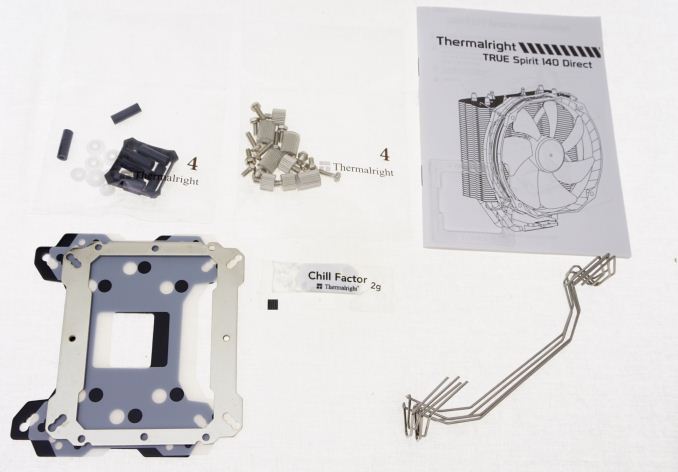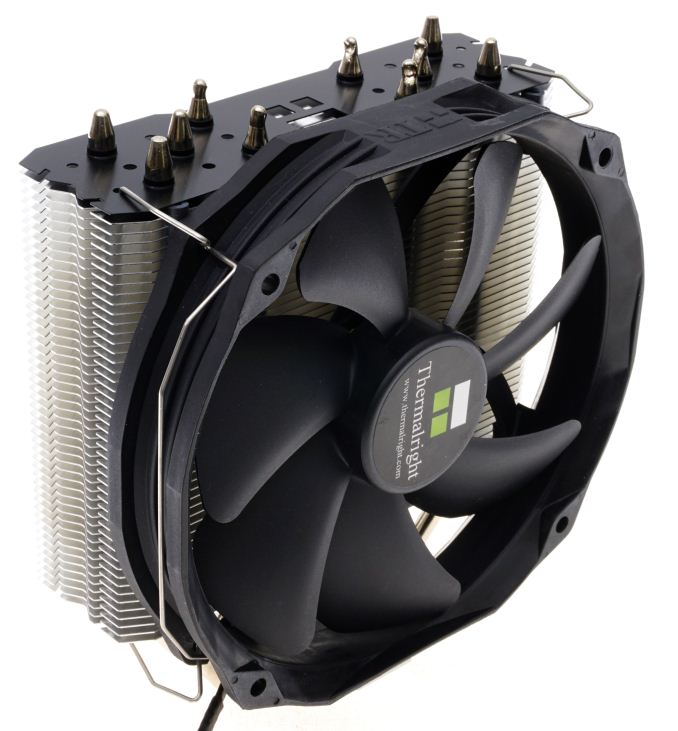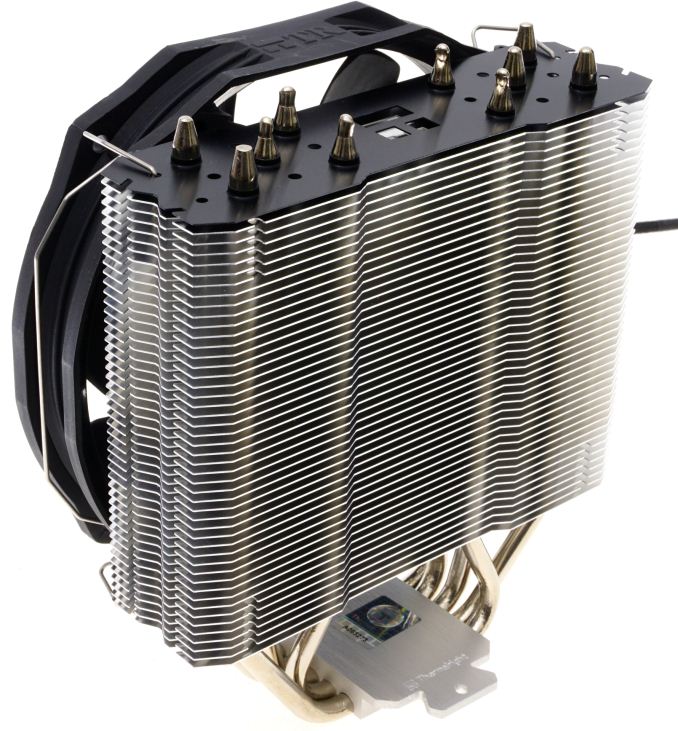The 140mm Slim Tower CPU Cooler Roundup: Thin & Light Done Just Right
by E. Fylladitakis on May 24, 2017 8:00 AM EST- Posted in
- Cases/Cooling/PSUs
- be quiet!
- Noctua
- Phanteks
- Cooler
- Thermalright
Thermalright True Spirit 140 Direct
Thermalright is practically a newcomer here in AnandTech, as we have not looked at any of their products since 2010 and our last Thermalright CPU cooler review is now nearly a decade old. The cooler that we will be reviewing today is the Thermalright True Spirit 140 Direct, the upgraded version of their popular Thermalright True Spirit 140 cooler. It comes supplied inside a dark box with minimal artwork, only a clear picture of the cooler itself and icon denoting its most important features.
Inside the box we only found the absolute necessary parts for the installation of the cooler, which are a one-fits-all backplate, mounting hardware, fan support wires, fan anti-vibration standoffs, and a small but detailed installation manual. Thermalright also supplies one dose of their “Chill Factor” thermal compound.
Much like Noctua’s and Be Quiet!’s offerings, the Thermalright True Spirit 140 Direct has a single 52 mm deep fin array with a 140 mm fan attached on it. The fin array is relatively simple, with only a recessed center area to reduce the aerodynamic drag noise. The top fin of the array has been painted black for aesthetic purposes. It has five 6 mm nickel-plated heatpipes.
Thermalright is using one of their TY-140 cooling fans on the True Spirit 140 Direct. The TY-140 is a PWM general purpose cooling fan that has been initially designed with 120 mm mounting holes to maximize compatibility. The company advertises its “Enhanced Hyper-Flow Bearing (EHFB)” engine as consistent and highly reliable, without any further information regarding its design and/or mechanics.
The fan mounting mechanism is strange, with the fan having to sit on rubber standoffs that need to be inserted into small cutouts on the fin array. It is not possible to mount the fan without these standoffs. Hopefully the rubber that they are made of will last for several years, but replacements may be necessary for people who keep their hardware for more than a few years or if they are lost. (Tip: Pieces of large drinking straws do work as a temporary solution)
The large difference between this cooler than the others in this roundup review (and also its major upgrade over the previous version) is the design of its base. Instead of having a contact plate coming in contact with the CPU and the heatpipes attached to it, the heatpipes of the True Spirit 140 Direct are in direct contact with the CPU itself. The top part of the base is made of machined aluminum and only provides mechanical cohesion and retention bracket support.
















74 Comments
View All Comments
Ian Cutress - Wednesday, May 24, 2017 - link
Are you measuring the heatsink, or the product? A lot of these companies go to great lengths to 'optimize' their fan design.fanofanand - Thursday, May 25, 2017 - link
I see this same type of comment applied to GPUs and cases too. Products should be tested exactly as they are sold. If a company wants to get their price under $x and they skimp on the case fans to do it, the reader should know that so they can price it appropriately by adding in the cost of good fans. Conversely if a company's price is higher but out of the box has the performance you would achieve from changing out the fans then that should be acknowledged and the reader be made aware. The way Anandtech does it is absolutely appropriate and allows the reader to get an accurate picture of what they are getting for the money.snarfbot - Thursday, May 25, 2017 - link
right, and like i said that is good, but when it comes to evaluating what product is best at specific noise levels the picture becomes less clear.isolating the performance of each cooler by using the same fan on each would help in that regard, and would be a cogent data point regardless imo.
in your testing methodology page you didnt mention whether you were using the boxed tim, or something like arctic silver for all products, as it is commonly accepted as the standard by which other tims are measured against in tech circles. i prefer mx-4, because its easier to use, but its good to have a standard to measure against.
you might do that to eliminate one variable from your test, and the same argument could be made for using one common fan across the board for that reason.
Infy2 - Wednesday, May 24, 2017 - link
Some comment on the difficulty of installation would be helpful. The inlcuded Noctua cooler has repuation of being easy to install while the Thermalright is not.gradoman - Saturday, May 27, 2017 - link
Late reply, but Thermalright's installation method is pretty simple these days. I'd say a half-step below Noctua's mounting system, but you're not going to be struggling to pin down sprung screws.https://youtu.be/EDRNBCH1lRA?t=1760
sheh - Wednesday, May 24, 2017 - link
Would be interesting to know their weights.Sivar - Wednesday, May 24, 2017 - link
Thank you for the useful, thorough review!Daisho11 - Wednesday, May 24, 2017 - link
It would be interesting to see how these heatsinks perform when they all use the same fan. Maybe test them all with the Noctua fan or some other popular variant (Corsair, GentleTyphoon, SanAce, etc.)Lolimaster - Thursday, May 25, 2017 - link
The efficieny and temps of Ryzen are so nice that you don't need AIO or big tower coolers, most of the time the stock cooler is more than enough, and it's silent :DI think the best cooler for Ryzen is the Coolermaster Hyper 212X, everything else is basically overkill.
Lolimaster - Thursday, May 25, 2017 - link
This will probably be nice for Ryzen 9 monsters.